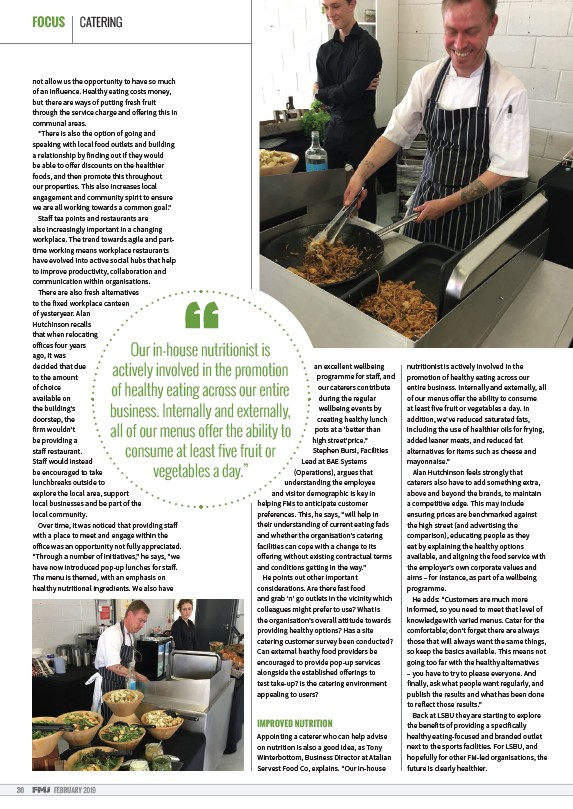
FOCUS CATERING
not allow us the opportunity to have so much
of an influence. Healthy eating costs money,
but there are ways of putting fresh fruit
through the service charge and o
ering this in
communal areas.
“There is also the option of going and
speaking with local food outlets and building
a relationship by finding out if they would
be able to o
er discounts on the healthier
foods, and then promote this throughout
our properties. This also increases local
engagement and community spirit to ensure
we are all working towards a common goal.”
Sta
tea points and restaurants are
also increasingly important in a changing
workplace. The trend towards agile and parttime
working means workplace restaurants
have evolved into active social hubs that help
to improve productivity, collaboration and
communication within organisations.
There are also fresh alternatives
to the fixed workplace canteen
of yesteryear. Alan
Hutchinson recalls
that when relocating
o
ices four years
ago, it was
decided that due
to the amount
of choice
available on
the building’s
doorstep, the
firm wouldn’t
be providing a
sta
restaurant.
Sta
would instead
be encouraged to take
lunchbreaks outside to
explore the local area, support
local businesses and be part of the
local community.
Over time, it was noticed that providing sta
with a place to meet and engage within the
o
ice was an opportunity not fully appreciated.
“Through a number of initiatives,” he says, “we
have now introduced pop-up lunches for sta
.
The menu is themed, with an emphasis on
healthy nutritional ingredients. We also have
30 FEBRUARY 2019
an excellent wellbeing
programme for sta
, and
our caterers contribute
during the regular
wellbeing events by
creating healthy lunch
pots at a ‘better than
high street’price.”
Stephen Bursi, Facilities
Lead at BAE Systems
(Operations), argues that
understanding the employee
and visitor demographic is key in
helping FMs to anticipate customer
preferences. This, he says, “will help in
their understanding of current eating fads
and whether the organisation’s catering
facilities can cope with a change to its
o
ering without existing contractual terms
and conditions getting in the way.”
He points out other important
considerations. Are there fast food
and grab ’n’ go outlets in the vicinity which
colleagues might prefer to use? What is
the organisation’s overall attitude towards
providing healthy options? Has a site
catering customer survey been conducted?
Can external heathy food providers be
encouraged to provide pop-up services
alongside the established o
erings to
test take-up? Is the catering environment
appealing to users?
IMPROVED NUTRITION
Appointing a caterer who can help advise
on nutrition is also a good idea, as Tony
Winterbottom, Business Director at Atalian
Servest Food Co, explains. “Our in-house
nutritionist is actively involved in the
promotion of healthy eating across our
entire business. Internally and externally, all
of our menus o
er the ability to consume
at least five fruit or vegetables a day. In
addition, we’ve reduced saturated fats,
including the use of healthier oils for frying,
added leaner meats, and reduced fat
alternatives for items such as cheese and
mayonnaise.”
Alan Hutchinson feels strongly that
caterers also have to add something extra,
above and beyond the brands, to maintain
a competitive edge. This may include
ensuring prices are benchmarked against
the high street (and advertising the
comparison), educating people as they
eat by explaining the healthy options
available, and aligning the food service with
the employer’s own corporate values and
aims – for instance, as part of a wellbeing
programme.
He adds: “Customers are much more
informed, so you need to meet that level of
knowledge with varied menus. Cater for the
comfortable; don’t forget there are always
those that will always want the same things,
so keep the basics available. This means not
going too far with the healthy alternatives
– you have to try to please everyone. And
finally, ask what people want regularly, and
publish the results and what has been done
to reflect those results.”
Back at LSBU they are starting to explore
the benefits of providing a specifically
healthy eating-focused and branded outlet
next to the sports facilities. For LSBU, and
hopefully for other FM-led organisations, the
future is clearly healthier.
2ur inhouse nutritionist is
actively involved in the promotion
of healthy eating across our entire
business. Internally and externally,
all of our menus off er the ability to
consume at least fi ve fruit or
vegetables a day.”